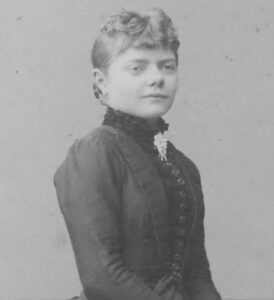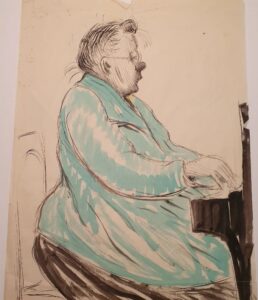We are happy to continue our series, Composers to Discover! featuring essays by students in the Public Musicology Certificate Program at Columbus State University, coordinated by Dr. Reba Wissner. Today’s essay is by Brandon Tharp. Brandon is completing an MM in choral conducting at the Schwob School of Music, Columbus State Univ., where he also completed a Bachelor of Music Education degree in choral music education.
One does not normally search for intellectual conversation in the comments section of a YouTube video. However, for the recording of Valborg Aulin’s Tableaux Parisiens op. 15, the comment section is just that: uplifting. One user cites how beautiful the piece is, although unknown. Another thanks the channel for exposing the musical community to a generally obscure composer.
Laura Valborg Aulin was born in Gävle, Sweden in 1860, but the family soon moved to Stockholm. During this time, the Scandinavian music scene was increasing its reputation with the likes of Edvard Grieg (1843–1907) and Jean Sibelius (1865–1957.) The Aulin family was part of this growth of interest. Valborg’s mother was an aspiring singer before she started their family, and her father was a devoted amateur violinist who taught secondary school. Valborg’s earliest musical training was piano lessons from Albert Rubenson, who was a teacher at the Royal Academy of Music (Stockholm). Yet, she was not the only family musician who focused on performing. Her younger brother, Tor Aulin (1866–1914), followed in his father’s footsteps by learning the violin and became a leader of a popular string quartet, as well as a composer.

Valborg Aulin, year unknown, Photo by Selma Jacobsson, Stockholm
Her musical training continued at age 17 when she enrolled at the Royal Academy of Music in Stockholm to study piano and composition. Eventually, a Jenny Lind Scholarship allowed her to travel to Copenhagen in 1885 and Paris in 1886. If earning the scholarship was not ence enough of her early talent, this excerpt from her sister-in-law’s diary puts it quite plainly: “Despite her total lack of outward charm, which Frenchmen are so highly appreciative of, she became popular due to her immense talent.” Her time as a student may not have been “charming” but it certainly gave her the tools and knowledge to return to her native land of Sweden and begin her professional career. In Sweden, her career as a pianist and teacher took center stage, with composing following alongside. After becoming an established musician in the Stockholm music circles, she left the capital at age 43 and moved to an inland city: Örebro (125 miles west of Stockholm.) Unfortunately, her move away from the capital negatively influenced the frequency of her music being programmed. Her music slowly left the public eye. Aulin died in Örebro in 1928.
Scholars speculate as to what inevitably brought her to leave the capital. Without distinct motivation regarding her departure, two camps of thought have developed to fill in the missing information. Most likely, the shared experience of women composers in this era suggests why she left. She may have become disgruntled with the challenges and roadblocks presented to her in Stockholm because she was a woman. This idea is supported by conservative musical ideologies still present in the nineteenth century. On the other hand, conflict with her mother or professional issues with her brother have been theorized as possibly prompting the departure from Stockholm. Regardless of motive, the outcome was detrimental to her career, but hopefully she found some peace in Örebro.
Her piano works were a central pillar of her compositional catalog. To the surprise of some, but a testament to her skill, many of the most successful compositions were from her time as a student. Sonata in F minor was written while in Denmark. This piece harkens to the rich romantic style of Robert Schumann, most likely the studied material for this composition. Her later piano compositions may be inspired by the works of Tchaikovsky, Schubert, Chopin, and Grieg, her famous Scandinavian colleague. However, the orchestral work Tableaux Parisiens op. 15 that I discovered on YouTube really caught my ear.
Tableaux Parisiens translates to Scenes of Paris. While studying with Benjamin Godard (1849–1895) and others in Paris in 1866, her orchestral tableaux took shape. One of the focuses of her studies was orchestration and instrumentation, which Aulin further supplemented by frequently attending orchestra concerts seeking inspiration. It appears she found it because Aulin wrote in a letter that Symphonie fantastique by Hector Berlioz made a strong impression on her, but the suite Scenes alsaciennes by Jules Massenet was the initial inspiration for her Tableaux Parisiens. Under the guidance of her teacher Godard, she completed the four-movement suite with a planned debut on February 22, 1888, in Sweden. However, due to “intervening obstacles” the performance was cancelled, and tragically, a live performance of the suite never happened during Aulin’s lifetime.
From the recent recording — Aulin, Moberg, Andrée: Orchestral Works, by the Gothenburg Symphony Orchestra
Listening to Laura Valborg Aulin’s only orchestral composition transports the listener to the streets of Paris, with music used to recreate cosmopolitan ambiance. In movement one, “Vie bruyante dans le lointain” (Noisy life in the distance), the title directs the listener’s ear to picture how the busy street has a life of its own. The opening violin tremolos pit this fast and furious articulation in contrast with the sweet and flowing low string melody that links the entire piece together. This melody is passed between all the parts, and in some ways feels like the river Seine, the heart of the city that connects so many of its districts. Bells – like the church bells of Paris – harken the conclusion of the movement. The resulting movements: “L’Église de la Madeleine” (The Church of the Madeleine), “Scène de bal” (Ball scene), and “Un soir de fête à Trocadero” (A festive evening at Trocadero) each create their own painting of what life in Paris is like, according to Aulin. The pacing and specificity in imagery projects Aulin’s compelling ode to the beauty and wonder she experienced while in Paris.
While actions of today are striving to create more equity for women composers, the big picture is often missed. Programming in choral and orchestral worlds have amazing modern-day women composers whose works are beginning to find equal footing in the current performance canon, but this creates a shadow where the women composers of the by-gone eras tend to be relegated to next in line or not at all. Someone Like Laura Valborg Aulin is no exception to this treatment, as are her many women contemporaries. Her music quickly fell out of circulation in part because of her self-inflicted exodus to the countryside. History may have forgotten her, but we must choose to not continue the neglect: now it is our turn to remind history of the beautiful piano works, choral music, and the hidden orchestral suite that Aulin deserved to have performed then, and now.
Links to Sources
https://www.swedishmusicalheritage.com/composers/aulin-valborg/
https://theamericanscholar.org/who-was-laura-valborg-aulin/
https://www.gso.se/en/upptack/podiet/three-world-premieres-on-one-board/

